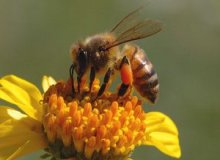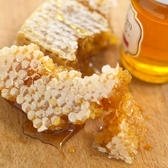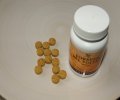Did you know that there are some 20,000 types of bees worldwide?
Honey bees are a mere fraction.
There are 7 main species and over 40 sub-species of Honey bees and all belong to the insect family ‘Hymenoptera’ that includes ants, wasps and sawflies.
Honey bees are special.
Unlike wasps and bumblebees, they over winter as a colony.
A colony stays active clustering together for warmth, it does not hibernate. This requires a lot of food stored, some 20-30 lb of honey, from the previous summer months. However it is not usually a problem as most hives will produce double that, given the room.
Click on the picture to enlarge

As we all know, it is the honey bees that produce honey, but there are three other healthy substances routinely removed from hives - Bee Pollen , Bee Propolis and Royal Jelly.
Honey bee colonies are made up of a queen bee, upwards of 50,000 undeveloped females (workers) and about 1,000 male bees (drones).
An amazing fact - A single honeybee can carry some 5 million grains of pollen on its body.
Only the females carry a sting!
Male bees, or drones, emerge within 24 days. They are larger than the female workers, having large eyes and no stinger.
This is the part you guys will love.
The males lead a life of leisure, do no work, being fed by the females.
Their sole purpose is to mate with a queen from any hive. This helps maintain the species by transfering their mother's genes.
But not this part....
Males die after mating, or get kicked out of the hive as winter approaches.
All over the world, wherever they find nectar, honeybees produce honey. Both the look and taste is down to three things.
- Weather
- Geographical location
- Different nectar sources
When heated, honey looses its healing properties, so the best choice is unfiltered 100% pure honey that is non-pasteurised and cold-pressed.
Cold-pressed honey is known to destroy a wide range of bacteria both in the stomach and intestines, providing a mild treatment for ailments like gastroenteritis and diarrhoea.

What I like about honey, apart from the taste, it is a natural sweetener, fat free, cholesterol free and contains fewer calories than sugar.
Use it on your morning cereal of porridge or toast and add some
cinnamon for that extra taste.
It is also a concentrated natural source of energy. This helps to feed the body, combat fatigue and provides a welcome healthy boost before, during and after exercise.
Just to show how long honey will keep, it was found in containers in the tomb of boy King Tutankhamun (1336-1327BC).
It was still edible. It never spoiled.
Please Note. Some people are allergic to bee products so please check before using.
What is Bee pollen?
Nutrients of Bee Pollen
Vitamins A, C, D, E
High concentrations of the B vitamin complex
Copper
Calcium
iron
Lecithin
Magnesium
Manganese
Potassium
Rutin
Zinc
High in amino acids
Bees collect about 20kg of pollen every year!
It is nature’s most complete food, a mix of flower pollen, nectar and bee digestive enzymes.
Bee pollen benefits include health and disorders, diseases, depression and skin disorders.
One excellent benefit of taking bee pollen is it's ability in reducing cholesterol levels.
For male health it has been found that bee pollen is also very effective in helping prevent prostate problems. It has a very track record in reversing both prostate cancer and prostatitis(which is the inflammation of the prostate).
It also helps to eliminate allergies like Hay Fever, so start having it 6 weeks before the allergy season and see the effects for yourself.
For my daily boost of energy I have a bee pollen tablet and always take an extra tablet whenever I play Badminton ( about 1/2hour before).
It also aids in strengthening the immune system.

These are tablets I take on a daily basis. Since taking them I feel much more alert and definately have bags more energy.
Check these out (along with the Propolis, Royal Jelly and other products - click here.
I believe taking extra tablets helped with a chest infection I had at the beginning of the year. I also had extra doses of Aloe gel drink and didn't have to resort to antibiotics.
The main problem with antibiotics is they kill ALL bacteria, good and bad.
Click to return to top of page
What is Bee Propolis?
It is a resin type substance produced mainly from the honey bees collecting tree sap, mixed with pollen, wax flakes and saliva. The honey bee uses propolis to seal the hive against predators and disease.
Propolis has antiseptic, antibiotic, antibacterial, antifungal, and even antiviral properties.
It is very helpful in the prevention of gum disease and can be found in toothgel.
As with the bee pollen, it also aids the immune system.
Nutrients of Bee Propolis
Vitmins A, B1, B2 and B3
virtually all vitamins except 'K'
albumin
biotin
bioflavonoids
calcium
cobalt
copper
iron
magnesium
manganese
phosphorus
potassium
silica
zinc
22 amino acids
Would you like to escape winter colds and sore throats?
Indications are that those who take bee propolis regularly seem to develop a natural immunity to common viruses, including the various strains of flu.
Click to return to top of page
What Is Royal Jelly?
Royal jelly is the only food given to the queen bee, hence the royal connection.
It is creamy white in colour, very rich in proteins and fatty acids and is produced by the mouth glands in young bees.
Only the queen receives royal jelly - this is just a myth. However, the queen, during her lifespan is only fed royal jelly.
Regarding the rest of the colony, all larvae are fed royal jelly, but only during the first 3 days of their life.
Because hives only produce a relatively small quantity, as a health product it is very expensive.
Nutrients of Royal Jelly
Vitamins A, C, D, E, B1, B2, B3, B6 and B12
A good source of Folic acid
All 8 of the essential amino acids
Taken on a regular basis it can have a positive effect on the human body. Such as cholesterol levels, eczema, diabetes, arthritis, asthma and even weight management.
These are but a few in a long list.
Click to return to top of page
Honey bees.
Their scientific name is 'Apis mellifera mellifera'.
Mellifera means 'honey bearing'.
One thing they are superb at is the pollination of fruits.
Well known fruits such as apple, pear, plum, raspberry, blackberry, cucumber, marrow and strawberries to name but a few.
Fruit is just a small section of the crops they pollinate.
In America many keepers can and do transport their honey bees thousands of miles to help in pollenation.
One area they go to is California, to the huge almond plantations.
Home Page - from - Honey Bees